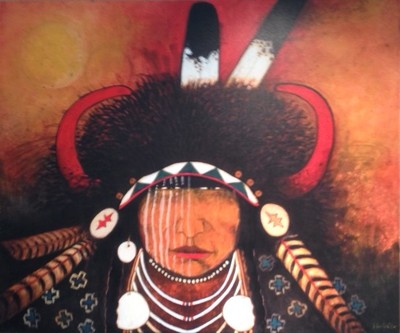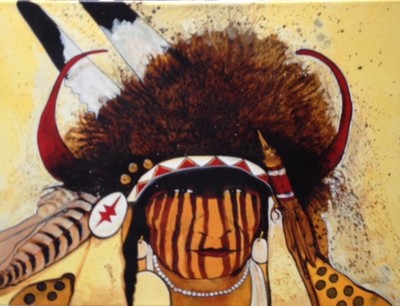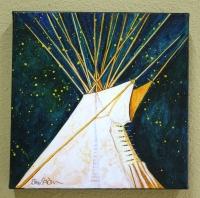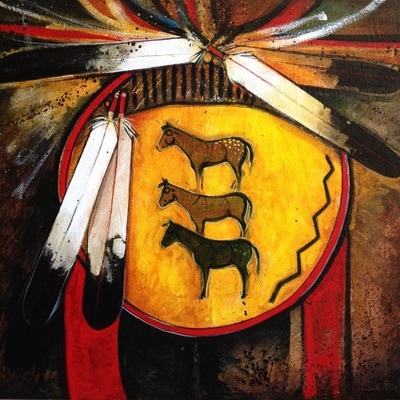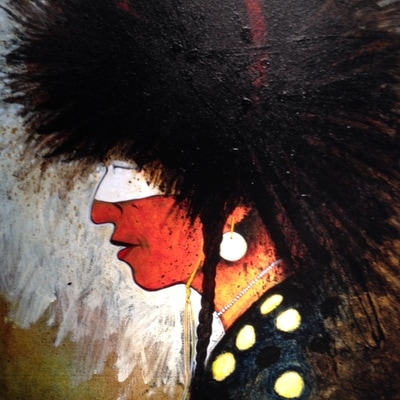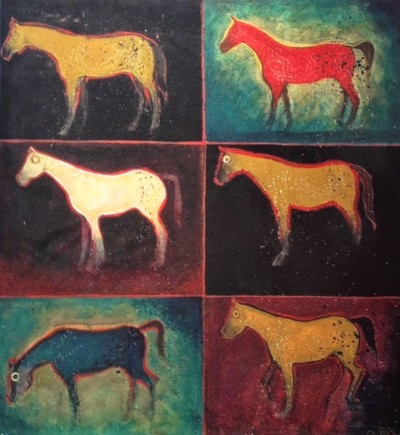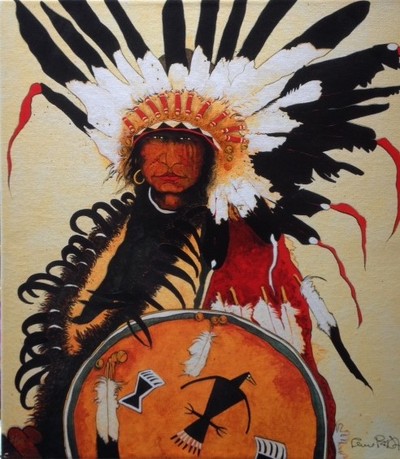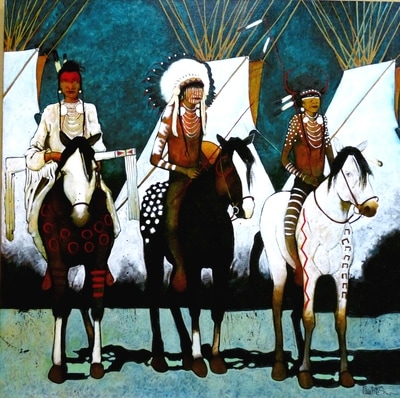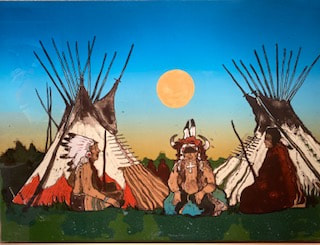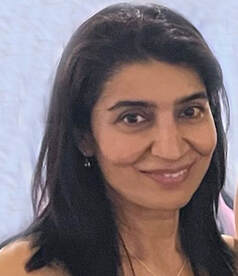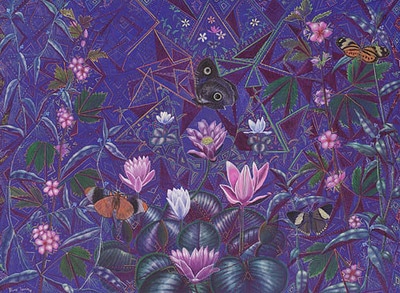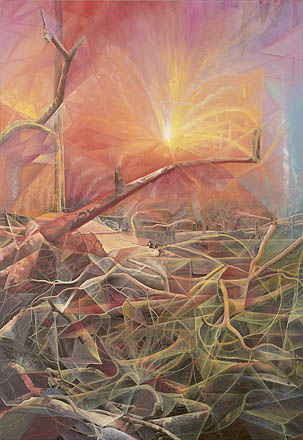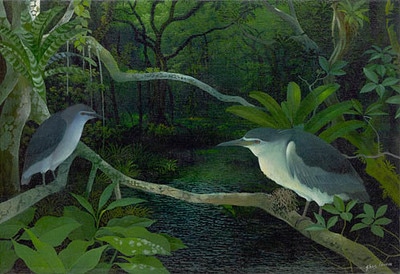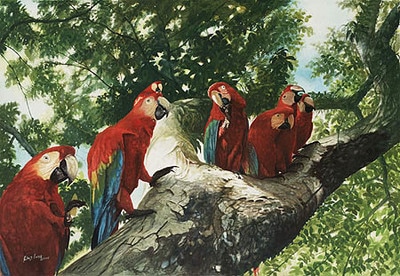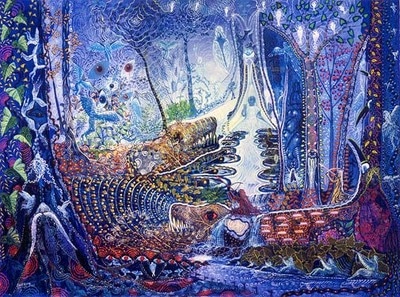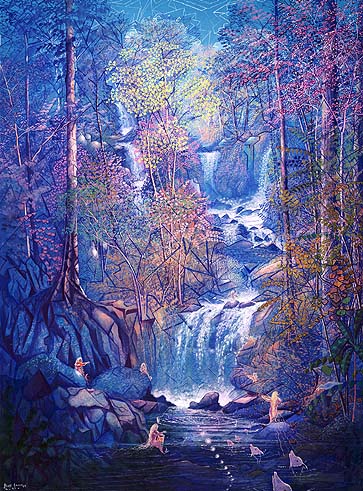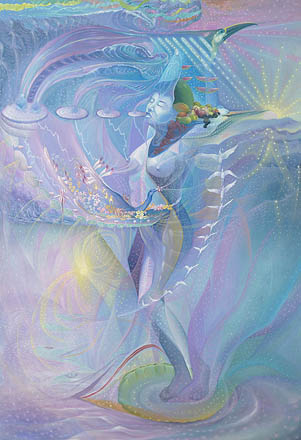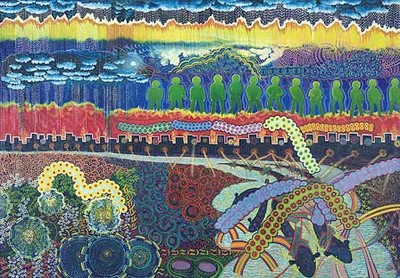Kevin Red Star
Kevin Red Star was born on the Crow Indian Reservation in Lodge Grass, Montana. He was raised in a family that values art and culture, where he developed an early love of drawing and music. This exposure and encouragement sustained him during his years in grade school during the time when Crow students were denied association with their language and cultural heritage.
Later, when he was one of 150 students chosen to attend the newly established Institute of American Indian Arts in Santa Fe, New Mexico, he was encouraged to explore his history and culture through modern art techniques. Upon graduation, Red Star and several other Native students received scholarships to the San Francisco Art Institute. Here he was exposed to the avant garde and political and social concerns of post-modern art.
Later, when he was one of 150 students chosen to attend the newly established Institute of American Indian Arts in Santa Fe, New Mexico, he was encouraged to explore his history and culture through modern art techniques. Upon graduation, Red Star and several other Native students received scholarships to the San Francisco Art Institute. Here he was exposed to the avant garde and political and social concerns of post-modern art.
Luby Haider
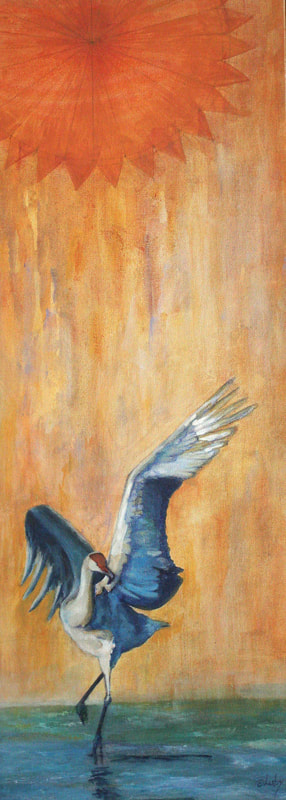 Blue Flamingo: Mixed Media, Acrylic, Ballpoint, & Coffee 10"x30"
Blue Flamingo: Mixed Media, Acrylic, Ballpoint, & Coffee 10"x30"
Luby is a professional artist based in St. Petersburg, Fl. Growing up in Pakistan she received her early education in sciences, destined to go to medical school. With a strong scientific background, she steered herself to study design, painting, and sculpture.
Luby received her M.A. in Art History from California State University, Los Angeles. While teaching art and architectural history to college students, she continued to study painting at the American Animation Institute. Her traditional training has evolved into using mixed media with oil and acrylic, ball point and coffee on canvas. The range of her professional work includes figurative and semi abstract subject matter, with a focus on symbolism.
ELVIS LUNA
Born on November 4, 1970, in Pucallpa, Peru, the very heart of the Amazon. At an early age, his mother surrounded him with music, flowers and poetry in the hope that he would develop an interest in the arts. His given name reflects her love of music and the indomitable spirit she imparted in him.
When Elvis was seven, he was sent to live with his uncle, a well-known curandero, or medicine man. For the next eight years, the young Elvis would endure the rigors of an apprenticeship into shamanism. It was then that he was introduced to the traditional belief system of the Amazonian spirit world, which describes an energetic substrate just beneath the visible world. Elvis explains that most Peruvians, and foreigners, are not prepared to understand or make contact with the plant and animal spirit world. "They look at the jungle and ask what they can get from it. The shaman sees the plants, as they really are, energetic beings with the same spirit and intelligence that we have. Once a person truly realizes this, he will never be the same again. He will no longer needlessly destroy or harm any living thing".
When he turned fifteen, Elvis returned home and began painting in watercolors. His tender renderings of native flora quickly gained him a local reputation and the attention of the world-renowned Peruvian painter Pablo Amaringo. An accomplished curandero himself, Sr. Amaringo furthered the young artists' spiritual insights. "The world that we see," Amaringo would say, "Is only a costume covering the souls of living things, it is the job of the artist to reveal this to others."
Elvis' landscapes look as if they were done Plein-Air, painted directly from life. With a delicate sense of the sublime, he gently leads us past the surface and into the heart of the Amazon. His intuitive understanding of light, and its manifold effects on the darker reflections of the jungle, offer us scenes that burn and glow in the imagination. In 1992, Elvis began exhibiting his works in museums and galleries in Columbia, Mexico, Brazil, England, Sweden, Finland, Norway, Germany and Italy. His paintings are part of numerous private collections in those countries. In 2003, he began his first representation here in the United States.
Following his vision beyond his own artistic career, Elvis founded the Green World Children's Amazon Art School, in Peru. His students, approximately 175 local children from outlying villages, are taught free of charge, in simple open-air classrooms. "It is not only painting that I teach the children, but, more importantly, I share the knowledge of the plant spirit-world and the idea that everything we see is the flesh of the world. When this happens, it transforms their lives. They naturally begin to show more self-respect, to share with each other, and respect their environment. This is the way that environmental work needs to be done, not from some NGO, (Non-Governmental Organization), sending money and telling us how to manage our land. It must begin in the hearts of the people that live here."
When Elvis was seven, he was sent to live with his uncle, a well-known curandero, or medicine man. For the next eight years, the young Elvis would endure the rigors of an apprenticeship into shamanism. It was then that he was introduced to the traditional belief system of the Amazonian spirit world, which describes an energetic substrate just beneath the visible world. Elvis explains that most Peruvians, and foreigners, are not prepared to understand or make contact with the plant and animal spirit world. "They look at the jungle and ask what they can get from it. The shaman sees the plants, as they really are, energetic beings with the same spirit and intelligence that we have. Once a person truly realizes this, he will never be the same again. He will no longer needlessly destroy or harm any living thing".
When he turned fifteen, Elvis returned home and began painting in watercolors. His tender renderings of native flora quickly gained him a local reputation and the attention of the world-renowned Peruvian painter Pablo Amaringo. An accomplished curandero himself, Sr. Amaringo furthered the young artists' spiritual insights. "The world that we see," Amaringo would say, "Is only a costume covering the souls of living things, it is the job of the artist to reveal this to others."
Elvis' landscapes look as if they were done Plein-Air, painted directly from life. With a delicate sense of the sublime, he gently leads us past the surface and into the heart of the Amazon. His intuitive understanding of light, and its manifold effects on the darker reflections of the jungle, offer us scenes that burn and glow in the imagination. In 1992, Elvis began exhibiting his works in museums and galleries in Columbia, Mexico, Brazil, England, Sweden, Finland, Norway, Germany and Italy. His paintings are part of numerous private collections in those countries. In 2003, he began his first representation here in the United States.
Following his vision beyond his own artistic career, Elvis founded the Green World Children's Amazon Art School, in Peru. His students, approximately 175 local children from outlying villages, are taught free of charge, in simple open-air classrooms. "It is not only painting that I teach the children, but, more importantly, I share the knowledge of the plant spirit-world and the idea that everything we see is the flesh of the world. When this happens, it transforms their lives. They naturally begin to show more self-respect, to share with each other, and respect their environment. This is the way that environmental work needs to be done, not from some NGO, (Non-Governmental Organization), sending money and telling us how to manage our land. It must begin in the hearts of the people that live here."
